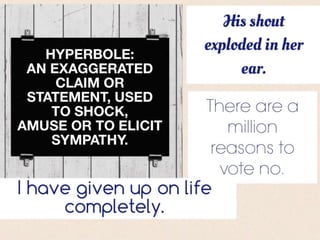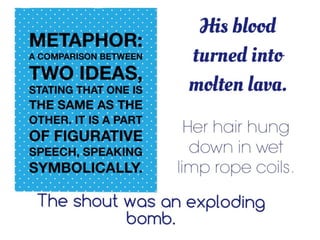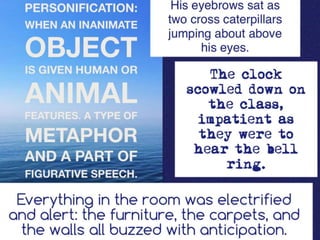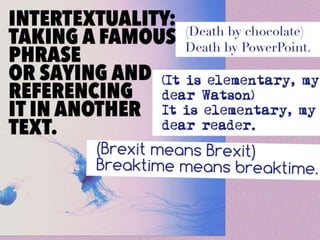Literary devices
Download as pptx, pdf1 like1,062 views
Created by Mrs Hallahan. https://twitter.com/heymrshallahan
1 of 19
Downloaded 15 times



















Ad
Recommended
Structure - By Mrs Hallahan
Structure - By Mrs HallahanAmjad Ali
╠²
George Orwell structured 1984 to build suspense and concern around the theme of government overreach. The passage begins by shifting Winston's focus from the ordinary to strange. It then introduces Winston and the dreary setting of Victory Mansions through brief yet evocative descriptions. The perspective then expands to convey clues about the dystopian society and intimate view of Winston's flat, emphasizing the themes of grayness and misery. Through these shifting focuses and perspectives, Orwell engages the reader in exploring his fears of totalitarian rule.Revision language paper 1 section a
Revision language paper 1 section aAmjad Ali
╠²
The writer structures the text to create suspense and interest the reader. It begins by focusing on the narrator's murder, shocking the reader. As it develops, details of the murderer, Mr. Harvey, are revealed through the narrator's impressions of him. These impressions develop suspense around his character. The closing lines maintain suspense by not revealing full details of the murder. Overall, the writer uses their structural choices effectively to engage the reader and build suspense throughout the extract.Preparing for GCSE Eng Lang/Lit
Preparing for GCSE Eng Lang/LitAmjad Ali
╠²
The document provides information about English literature and language exams, including:
- There are 4 exams total across 2 papers
- Exams cover topics like Macbeth, Dr. Jekyll and Mr. Hyde, poetry, unseen poetry, and language analysis
- Each exam is between 1-2 hours and 15 minutes with varying maximum marks
- Questions follow different formats including short answers, longer essays, comparisons, and language analysis requiring evidence from passages.AQA- English Language Mock
AQA- English Language MockAmjad Ali
╠²
This document provides an overview of the format and structure of a GCSE English Language Paper 1 exam. It includes:
- A reading section with 4 comprehension questions about a fiction passage, testing identification of explicit details, language analysis, structure analysis, and a critical response.
- A writing section with 2 potential essay prompts, testing content, organization, vocabulary, sentence structure, and technical accuracy.
- Guidance is given for each question, including timing, skills tested, and techniques for answering successfully like highlighting examples and commenting on language effects. Close attention to language features and how they impact the reader is emphasized.Macbeth knowledge organiser 2
Macbeth knowledge organiser 2Amjad Ali
╠²
The document provides a detailed summary of the plot of Shakespeare's play Macbeth. It outlines the key events in each act, including Macbeth and Banquo meeting the witches, Macbeth killing King Duncan after being convinced by his wife Lady Macbeth, Macbeth becoming king and later having Banquo murdered due to another prophecy by the witches, and the final battle in which Macbeth is defeated and killed by Macduff. It also includes brief character descriptions and definitions of literary techniques and themes in the play, such as supernatural elements, ambition, and the conflict between good and evil.AQA GCSE Eng. Lit
AQA GCSE Eng. LitAmjad Ali
╠²
This document provides a step-by-step guide for a mock exam on poetry analysis. It instructs students to 1) identify the key idea in the question, 2) choose a comparative poem, 3) write an introduction comparing the two poems, 4) write paragraphs analyzing imagery/language and form/structure in each poem, and 5) write a conclusion comparing how duty is presented in the two poems and how attitudes have changed over time.AIC booklet english literature
AIC booklet english literatureAmjad Ali
╠²
This document provides an overview and assessment information for the English Literature GCSE. It discusses two papers - Paper 1 which assesses Shakespeare and a 19th century novel, and Paper 2 which assesses a modern text, poetry, and unseen poetry. For each paper it provides details on what is assessed, how it is assessed (including timing and marks), and the types of questions students will face. It also outlines the assessment objectives and skills that will be evaluated. The last sections provide vocabulary terms and their definitions to aid students in understanding concepts in the modern text of An Inspector Calls.Macbeth Booklet
Macbeth BookletAmjad Ali
╠²
In Act 1 of Macbeth, three witches prophesy that Macbeth will become Thane of Cawdor and king. Their prophecy comes true when Macbeth is named Thane of Cawdor for his victory in battle. Inspired by his wife Lady Macbeth, Macbeth murders King Duncan while he stays at their castle, fulfilling the second part of the prophecy. However, Macbeth begins to feel paranoid about losing his new position as threats to his rule emerge.AQA- Power and Conflict Revision Resource
AQA- Power and Conflict Revision ResourceAmjad Ali
╠²
This document provides an overview and contents of a booklet designed to support the study of poetry for English lessons. It discusses how the booklet can be used as a homework resource, revision aid, or to catch up on missed topics. However, it notes that the booklet is not intended as a "quick fix" and emphasizes the importance of carefully reading the instructions and answering questions in full sentences. The document also provides teaching suggestions for incorporating the booklet into lessons, such as exploring poems in stages from initial understanding to reinforcement of themes. It highlights assessment objectives for poetry analysis and includes a glossary of literary devices.English Literature Paper 1 and Paper 2
English Literature Paper 1 and Paper 2Amjad Ali
╠²
This document provides guidance and assessment objectives for students taking a literature exam consisting of multiple questions. It includes sample exam questions on Shakespeare, a 19th century novel, modern texts, poetry, and unseen poetry. For each question, it lists the assessment objectives, key content to discuss in responses, and level descriptors for marking. The document aims to help students understand what is required to answer questions successfully and achieve higher marks in the literature exam.Information on symbolism
Information on symbolismAmjad Ali
╠²
The dome atop the prayer hall symbolizes heaven and provides practical benefits like carrying the imam's voice and keeping the hall cool. The minaret allows the call to prayer to be heard from afar and helps people locate the mosque. The prayer hall contains no chairs as worshippers kneel and prostrate on carpets, with men and women separated. The mihrab indicates the qibla direction of Makkah. Prayer mats contain symbols like the mihrab arch to guide correct worship orientation. Calligraphy from the Qur'an decorates walls in place of images.Northern Rocks Workshop- Amjad Ali- @ASTSupportaali
Northern Rocks Workshop- Amjad Ali- @ASTSupportaaliAmjad Ali
╠²
The 'agility teaching toolkit of ideas' emphasizes that all students can succeed through effort rather than achievement, advocating for differentiated approaches based on individual needs. It provides strategies for motivating students, addressing challenges, and utilizing specific marking goals to foster positive change in teaching practices. Additionally, it highlights the importance of resources and support for diverse learners, including those with special educational needs and language barriers.GCSE Citizenship Revision Notes- Year 10
GCSE Citizenship Revision Notes- Year 10Amjad Ali
╠²
The document provides information about identities, communities, and citizenship in the UK. It discusses what it means to be British and outlines some cultural traditions. It also describes value systems in British society such as personal freedom, equal opportunity, representative democracy, and British law. Additionally, it defines key terms related to identities, communities, religions, ethnic groups, and the history of immigration and diversity in Britain. It provides information on human rights, democracy, voting systems, and the UK's relationship with international organizations like the European Union and United Nations.Quick Summary Revision- Looking For Meaning
Quick Summary Revision- Looking For MeaningAmjad Ali
╠²
This document provides information about religious beliefs in different traditions. It includes:
- Key terms like atheist, theist, and agnostic to describe different beliefs about God.
- Descriptions of God in Christianity as the Trinity and in Islam as Allah, the all-powerful creator.
- Teachings about the afterlife in Christianity of heaven and hell and resurrection, and in Islam of judgement and paradise.
- Information about religious funeral rites in Christianity involving communion and committal, and in Islam involving washing the body and burial facing Mecca.TMOxford Jamie kirkaldy
TMOxford Jamie kirkaldyAmjad Ali
╠²
The document provides guidance and tips for students taking mock exams in preparation for the Reading section of an exam. It emphasizes the following skills needed to do well on the Reading section: reading and understanding non-fiction texts; selecting quotations from the texts to support ideas; comparing and cross-referencing multiple texts; commenting on the use of language and its impact on the reader; and organizing responses into effective paragraphs with good punctuation and spelling. The document then guides students through sample exam questions, providing success criteria for skills and excellent answers. It advises students to reflect on their performance, identifying their strengths and areas for improvement.Symbolism in mosques
Symbolism in mosquesAmjad Ali
╠²
This document provides information about mosques and how Muslims prepare their place of worship for prayer. It includes:
- Learning objectives about describing what a mosque looks like, explaining why there are no images in mosques, and comparing how Christianity and Islam prepare for prayer.
- Details about the parts of a mosque like the dome, minaret, prayer hall, and mihrab, as well as activities like watching a video, discussing mosque features, and adding information to a mosque floorplan.
- Information on Muslims joining together for Friday prayers at the mosque to strengthen their sense of community and faith by listening to religious lessons.Content Marketing: 50 Words That Will Help Improve Your Next 500 Blog Posts
Content Marketing: 50 Words That Will Help Improve Your Next 500 Blog PostsRaven Tools
╠²
The document discusses strategies for improving blog post planning through the use of editorial calendars and budgets. It defines key terms such as editorial calendar, editorial budget, and budget lines, and emphasizes the importance of organization and flexibility in content planning. It also addresses common problems faced in managing these tools and suggests solutions for better content management.Paper 2 revision ppt
Paper 2 revision pptmvcenglish
╠²
The document provides guidance for a two hour exam consisting of two sections. Section A is a 50 minute reading comprehension section with questions on two non-fiction texts on a common theme. Section B is a 70 minute writing section requiring two transactional pieces of writing with attention to audience and purpose. Tips are provided on question types for the reading section and how to approach the two writing tasks.What is the Quran and Hadith
What is the Quran and HadithAmjad Ali
╠²
This document discusses sources of authority in Islam. The two primary sources are the Quran and Hadith. The Quran is considered the ultimate authority, as it contains the direct words of God revealed to Muhammad. It is written in Arabic and provides guidance to Muslims. The Hadith contains the sayings and actions of Muhammad, and is used to help interpret the Quran. Both sources provide teachings that influence Muslims' beliefs and how they apply their faith to different situations. The document explores how Muslims may use these religious texts to find guidance on issues and how interpretation can sometimes lead to conflict between beliefs and authority.Punishment
PunishmentAmjad Ali
╠²
This document discusses different types and purposes of punishment. It includes sections that define punishment, discuss reasons for punishment like deterrence and rehabilitation, and ask students to consider what types of crimes warrant what types of punishments. Students are asked to evaluate different aims of punishment and form their own opinions on the purpose of punishment.Full Course RE Exam- Revision0 Relationships
Full Course RE Exam- Revision0 RelationshipsAmjad Ali
╠²
1) The document provides information about key terms related to relationships and marriage from a Christian and Muslim perspective.
2) It describes the typical ceremonies for Christian weddings which take place in a church and involve vows, rings, and blessings, and Muslim weddings which involve signing a marriage contract and readings from the Quran.
3) Views on divorce are discussed, including that Christians believe in reconciliation over divorce if possible, and Muslims allow divorce but see it as undesirable, going through a waiting period and pronouncements of divorce.War phtographer overview
War phtographer overviewmrbunkeredu
╠²
The poem explores the perspective of a war photographer who documents human suffering in conflict zones. In three sentences:
The photographer develops photos showing "spools of suffering" in solitary work, contrasting the horrors captured with memories of "ordinary pain" in rural England. However, capturing images of agony offers little solace as editors select just a few while readers' eyes may water but they ultimately "do not care" and prioritize "pre-lunch beers".Knowledge organiser y11 power and conflict poetry
Knowledge organiser y11 power and conflict poetrymrbunkeredu
╠²
The document provides summaries of 14 poems:
- Ozymandias by Percy Bysshe Shelley discusses the ruins of a statue and the fleeting nature of power and pride.
- The Prelude by William Wordsworth explores the author's life experiences and relationship with nature.
- My Last Duchess by Robert Browning depicts a Duke who was angered by his former wife's flirtatious behavior.
- Exposure by Wilfred Owen reveals the author's anger towards the horrific conditions of World War I in the trenches.
- Storm on the Island by Seamus Heaney uses violent imagery to describe a community's fear as a powerful storm hits.Christian pilgrimage
Christian pilgrimageAmjad Ali
╠²
This document provides information about Christian pilgrimages and compares them to holidays. It includes definitions of "holiday" and "pilgrimage" and discusses why pilgrimages are important to some Christians. Students study various Christian pilgrimage sites and create posters about one site. They then practice answering an 8-mark question comparing pilgrimages to holidays and discussing religious views. The document emphasizes that pilgrimages can help with spiritual growth by traveling to holy sites important in the Christian faith.Sharing faith with others
Sharing faith with othersAmjad Ali
╠²
This document discusses evangelism and sharing faith with others. It defines evangelism as referring to preaching one's faith to others and discusses whether people should share their faith. Some reasons provided include that it is part of some religious identities and duties, and it allows others to learn about different practices, though it could also lead to discrimination or trying to change others' beliefs in a multi-faith society. The document provides tasks for students to complete around this topic.Macbeth PEE+ example
Macbeth PEE+ exampleMsCaldwell
╠²
Pupils will write a 2000 word essay comparing Shakespeare's Macbeth to another text. They will be assessed on their ability to critically analyze language, structure and themes; make comparisons between texts; and discuss the historical context. Teachers provide examples of how to structure paragraphs using Point, Evidence, Explanation and further context (PEE+) to ensure analytical writing rather than storytelling.Cpd carousel revision strategies
Cpd carousel revision strategiesAmjad Ali
╠²
Revision refers to the process of editing, correcting, altering, or adapting something that was previously created. Effective revision strategies include re-reading notes or materials, re-writing key points, organizing information, and practicing retrieving information from memory rather than just recognizing familiar concepts. Revision requires time, avoiding distractions, spacing out practice over time in order to strengthen memory and understanding of concepts through deliberate practice.Hajj
HajjAmjad Ali
╠²
The document discusses the Muslim pilgrimage known as Hajj. It provides instructions for students to learn about the different elements of Hajj, including creating a flow diagram illustrating the various stages. These stages include dressing in ihram clothing, circling the Ka'bah building, traveling to Mount Arafat to stand in prayer, and throwing stones in Mina. The document suggests Hajj is meant to strengthen believers' faiths and encourage spiritual transformation through immersion in religious atmospheres and rituals.Symbolism in churches
Symbolism in churches Amjad Ali
╠²
This document provides information about symbolism in different types of Christian churches. It includes tasks for students to learn about and compare the Baptist, Catholic, Church of England, Greek Orthodox, Free Church, and Quaker denominations. Students are asked to create posters and drawings showing the symbols and important parts of each church. They also complete a cloze activity about worship in churches and design a new multi-denominational church explaining their choices.More Related Content
Viewers also liked (19)
Macbeth Booklet
Macbeth BookletAmjad Ali
╠²
In Act 1 of Macbeth, three witches prophesy that Macbeth will become Thane of Cawdor and king. Their prophecy comes true when Macbeth is named Thane of Cawdor for his victory in battle. Inspired by his wife Lady Macbeth, Macbeth murders King Duncan while he stays at their castle, fulfilling the second part of the prophecy. However, Macbeth begins to feel paranoid about losing his new position as threats to his rule emerge.AQA- Power and Conflict Revision Resource
AQA- Power and Conflict Revision ResourceAmjad Ali
╠²
This document provides an overview and contents of a booklet designed to support the study of poetry for English lessons. It discusses how the booklet can be used as a homework resource, revision aid, or to catch up on missed topics. However, it notes that the booklet is not intended as a "quick fix" and emphasizes the importance of carefully reading the instructions and answering questions in full sentences. The document also provides teaching suggestions for incorporating the booklet into lessons, such as exploring poems in stages from initial understanding to reinforcement of themes. It highlights assessment objectives for poetry analysis and includes a glossary of literary devices.English Literature Paper 1 and Paper 2
English Literature Paper 1 and Paper 2Amjad Ali
╠²
This document provides guidance and assessment objectives for students taking a literature exam consisting of multiple questions. It includes sample exam questions on Shakespeare, a 19th century novel, modern texts, poetry, and unseen poetry. For each question, it lists the assessment objectives, key content to discuss in responses, and level descriptors for marking. The document aims to help students understand what is required to answer questions successfully and achieve higher marks in the literature exam.Information on symbolism
Information on symbolismAmjad Ali
╠²
The dome atop the prayer hall symbolizes heaven and provides practical benefits like carrying the imam's voice and keeping the hall cool. The minaret allows the call to prayer to be heard from afar and helps people locate the mosque. The prayer hall contains no chairs as worshippers kneel and prostrate on carpets, with men and women separated. The mihrab indicates the qibla direction of Makkah. Prayer mats contain symbols like the mihrab arch to guide correct worship orientation. Calligraphy from the Qur'an decorates walls in place of images.Northern Rocks Workshop- Amjad Ali- @ASTSupportaali
Northern Rocks Workshop- Amjad Ali- @ASTSupportaaliAmjad Ali
╠²
The 'agility teaching toolkit of ideas' emphasizes that all students can succeed through effort rather than achievement, advocating for differentiated approaches based on individual needs. It provides strategies for motivating students, addressing challenges, and utilizing specific marking goals to foster positive change in teaching practices. Additionally, it highlights the importance of resources and support for diverse learners, including those with special educational needs and language barriers.GCSE Citizenship Revision Notes- Year 10
GCSE Citizenship Revision Notes- Year 10Amjad Ali
╠²
The document provides information about identities, communities, and citizenship in the UK. It discusses what it means to be British and outlines some cultural traditions. It also describes value systems in British society such as personal freedom, equal opportunity, representative democracy, and British law. Additionally, it defines key terms related to identities, communities, religions, ethnic groups, and the history of immigration and diversity in Britain. It provides information on human rights, democracy, voting systems, and the UK's relationship with international organizations like the European Union and United Nations.Quick Summary Revision- Looking For Meaning
Quick Summary Revision- Looking For MeaningAmjad Ali
╠²
This document provides information about religious beliefs in different traditions. It includes:
- Key terms like atheist, theist, and agnostic to describe different beliefs about God.
- Descriptions of God in Christianity as the Trinity and in Islam as Allah, the all-powerful creator.
- Teachings about the afterlife in Christianity of heaven and hell and resurrection, and in Islam of judgement and paradise.
- Information about religious funeral rites in Christianity involving communion and committal, and in Islam involving washing the body and burial facing Mecca.TMOxford Jamie kirkaldy
TMOxford Jamie kirkaldyAmjad Ali
╠²
The document provides guidance and tips for students taking mock exams in preparation for the Reading section of an exam. It emphasizes the following skills needed to do well on the Reading section: reading and understanding non-fiction texts; selecting quotations from the texts to support ideas; comparing and cross-referencing multiple texts; commenting on the use of language and its impact on the reader; and organizing responses into effective paragraphs with good punctuation and spelling. The document then guides students through sample exam questions, providing success criteria for skills and excellent answers. It advises students to reflect on their performance, identifying their strengths and areas for improvement.Symbolism in mosques
Symbolism in mosquesAmjad Ali
╠²
This document provides information about mosques and how Muslims prepare their place of worship for prayer. It includes:
- Learning objectives about describing what a mosque looks like, explaining why there are no images in mosques, and comparing how Christianity and Islam prepare for prayer.
- Details about the parts of a mosque like the dome, minaret, prayer hall, and mihrab, as well as activities like watching a video, discussing mosque features, and adding information to a mosque floorplan.
- Information on Muslims joining together for Friday prayers at the mosque to strengthen their sense of community and faith by listening to religious lessons.Content Marketing: 50 Words That Will Help Improve Your Next 500 Blog Posts
Content Marketing: 50 Words That Will Help Improve Your Next 500 Blog PostsRaven Tools
╠²
The document discusses strategies for improving blog post planning through the use of editorial calendars and budgets. It defines key terms such as editorial calendar, editorial budget, and budget lines, and emphasizes the importance of organization and flexibility in content planning. It also addresses common problems faced in managing these tools and suggests solutions for better content management.Paper 2 revision ppt
Paper 2 revision pptmvcenglish
╠²
The document provides guidance for a two hour exam consisting of two sections. Section A is a 50 minute reading comprehension section with questions on two non-fiction texts on a common theme. Section B is a 70 minute writing section requiring two transactional pieces of writing with attention to audience and purpose. Tips are provided on question types for the reading section and how to approach the two writing tasks.What is the Quran and Hadith
What is the Quran and HadithAmjad Ali
╠²
This document discusses sources of authority in Islam. The two primary sources are the Quran and Hadith. The Quran is considered the ultimate authority, as it contains the direct words of God revealed to Muhammad. It is written in Arabic and provides guidance to Muslims. The Hadith contains the sayings and actions of Muhammad, and is used to help interpret the Quran. Both sources provide teachings that influence Muslims' beliefs and how they apply their faith to different situations. The document explores how Muslims may use these religious texts to find guidance on issues and how interpretation can sometimes lead to conflict between beliefs and authority.Punishment
PunishmentAmjad Ali
╠²
This document discusses different types and purposes of punishment. It includes sections that define punishment, discuss reasons for punishment like deterrence and rehabilitation, and ask students to consider what types of crimes warrant what types of punishments. Students are asked to evaluate different aims of punishment and form their own opinions on the purpose of punishment.Full Course RE Exam- Revision0 Relationships
Full Course RE Exam- Revision0 RelationshipsAmjad Ali
╠²
1) The document provides information about key terms related to relationships and marriage from a Christian and Muslim perspective.
2) It describes the typical ceremonies for Christian weddings which take place in a church and involve vows, rings, and blessings, and Muslim weddings which involve signing a marriage contract and readings from the Quran.
3) Views on divorce are discussed, including that Christians believe in reconciliation over divorce if possible, and Muslims allow divorce but see it as undesirable, going through a waiting period and pronouncements of divorce.War phtographer overview
War phtographer overviewmrbunkeredu
╠²
The poem explores the perspective of a war photographer who documents human suffering in conflict zones. In three sentences:
The photographer develops photos showing "spools of suffering" in solitary work, contrasting the horrors captured with memories of "ordinary pain" in rural England. However, capturing images of agony offers little solace as editors select just a few while readers' eyes may water but they ultimately "do not care" and prioritize "pre-lunch beers".Knowledge organiser y11 power and conflict poetry
Knowledge organiser y11 power and conflict poetrymrbunkeredu
╠²
The document provides summaries of 14 poems:
- Ozymandias by Percy Bysshe Shelley discusses the ruins of a statue and the fleeting nature of power and pride.
- The Prelude by William Wordsworth explores the author's life experiences and relationship with nature.
- My Last Duchess by Robert Browning depicts a Duke who was angered by his former wife's flirtatious behavior.
- Exposure by Wilfred Owen reveals the author's anger towards the horrific conditions of World War I in the trenches.
- Storm on the Island by Seamus Heaney uses violent imagery to describe a community's fear as a powerful storm hits.Christian pilgrimage
Christian pilgrimageAmjad Ali
╠²
This document provides information about Christian pilgrimages and compares them to holidays. It includes definitions of "holiday" and "pilgrimage" and discusses why pilgrimages are important to some Christians. Students study various Christian pilgrimage sites and create posters about one site. They then practice answering an 8-mark question comparing pilgrimages to holidays and discussing religious views. The document emphasizes that pilgrimages can help with spiritual growth by traveling to holy sites important in the Christian faith.Sharing faith with others
Sharing faith with othersAmjad Ali
╠²
This document discusses evangelism and sharing faith with others. It defines evangelism as referring to preaching one's faith to others and discusses whether people should share their faith. Some reasons provided include that it is part of some religious identities and duties, and it allows others to learn about different practices, though it could also lead to discrimination or trying to change others' beliefs in a multi-faith society. The document provides tasks for students to complete around this topic.Macbeth PEE+ example
Macbeth PEE+ exampleMsCaldwell
╠²
Pupils will write a 2000 word essay comparing Shakespeare's Macbeth to another text. They will be assessed on their ability to critically analyze language, structure and themes; make comparisons between texts; and discuss the historical context. Teachers provide examples of how to structure paragraphs using Point, Evidence, Explanation and further context (PEE+) to ensure analytical writing rather than storytelling.More from Amjad Ali (13)
Cpd carousel revision strategies
Cpd carousel revision strategiesAmjad Ali
╠²
Revision refers to the process of editing, correcting, altering, or adapting something that was previously created. Effective revision strategies include re-reading notes or materials, re-writing key points, organizing information, and practicing retrieving information from memory rather than just recognizing familiar concepts. Revision requires time, avoiding distractions, spacing out practice over time in order to strengthen memory and understanding of concepts through deliberate practice.Hajj
HajjAmjad Ali
╠²
The document discusses the Muslim pilgrimage known as Hajj. It provides instructions for students to learn about the different elements of Hajj, including creating a flow diagram illustrating the various stages. These stages include dressing in ihram clothing, circling the Ka'bah building, traveling to Mount Arafat to stand in prayer, and throwing stones in Mina. The document suggests Hajj is meant to strengthen believers' faiths and encourage spiritual transformation through immersion in religious atmospheres and rituals.Symbolism in churches
Symbolism in churches Amjad Ali
╠²
This document provides information about symbolism in different types of Christian churches. It includes tasks for students to learn about and compare the Baptist, Catholic, Church of England, Greek Orthodox, Free Church, and Quaker denominations. Students are asked to create posters and drawings showing the symbols and important parts of each church. They also complete a cloze activity about worship in churches and design a new multi-denominational church explaining their choices.Year 9 Units- Checklists
Year 9 Units- ChecklistsAmjad Ali
╠²
This document discusses several topics related to religious beliefs and human experiences:
- Topic 1 examines relationships, issues of love, marriage, divorce and same-sex relationships. It explores religious teachings around sex, commitment, and the purpose and importance of marriage.
- Topic 2 focuses on issues of justice and equality. It looks at religious responses to inequality, prejudice, wealth, social responsibility and how religions promote justice and fair treatment of all people.
- Topic 3 is about finding meaning and addresses questions of God's existence, religious symbols, experiences of God, beliefs about death and the afterlife, and the value of religion in society.Our World- Quick Summary Revision
Our World- Quick Summary RevisionAmjad Ali
╠²
This document provides an outline for a Year 10 religious studies lesson on creation and humanity's role in the world. It includes key terms to define, learning objectives, topics to cover such as the Christian, Islamic and scientific views of creation. It directs students to take notes on issues in the topic and copy a Venn diagram. It provides information on the roles of humanity and stewardship according to Christianity and Islam. Students are given exam practice questions and a plenary to identify areas needing further learning.Demonstrating God
Demonstrating GodAmjad Ali
╠²
This document provides information about different ways that religious people can respond to and connect with God. It includes key terms like community and vocation. Students learn about individual responses like prayer and dedication, and group responses like worship, pilgrimage, and service to others. The document instructs students to create posters explaining different methods of responding to God in 20 words or less. It emphasizes both individual and group types of worship.Joint Mind Maps- RE- WJEC
Joint Mind Maps- RE- WJECAmjad Ali
╠²
Joint Mind Maps- RE- WJEC
Mixture of Ao1 and Ao2 points for all 8 units- WJEC.
Student Made.IVF Lessons-
IVF Lessons-Amjad Ali
╠²
The document provides information about different religious views on in vitro fertilization (IVF). It discusses what some Christians and Muslims believe about IVF. Some Christians believe IVF is acceptable if it helps infertile couples and uses the biological parents' sperm and egg. However, others argue that a child is a gift from God, IVF is too expensive when money could help starving children, and spare embryos are destroyed. The document also mentions that Muslims generally accept IVF if the sperm and egg belong to a married couple. It asks students to consider these different perspectives on issues like the sanctity of life.Euthanasia
EuthanasiaAmjad Ali
╠²
This document provides information about euthanasia from a religious studies perspective. It defines euthanasia and the two main types: voluntary and involuntary. It discusses Christian, Muslim, and non-religious views on euthanasia. Two case studies are presented: Dianne Pretty, who appealed courts to allow her husband to help her die, and Tony Bland, who was in a persistent vegetative state and his family petitioned to withdraw life support. Christian views are that all life comes from God and is sacred, so taking life would be wrong. However, alleviating suffering is acceptable. Muslims are totally opposed as only Allah can determine life and death. Non-religious arguments for and against are alsoAbortion- religious views
Abortion- religious viewsAmjad Ali
╠²
The document compares Christian and Muslim viewpoints on abortion. It provides information on the sanctity of life in most religions and then discusses specific Christian and Muslim perspectives. For Christianity, it outlines that the Bible suggests life begins at conception and notes stances of the Roman Catholic Church, which strongly opposes abortion, and the Church of England, which allows for abortion in some situations. For Islam, it mentions the Quran is against killing born and unborn children and most Muslim scholars believe the fetus becomes human at 120 days, allowing abortion before then for valid reasons. The document aims to help students understand and compare different religious attitudes toward abortion.Abortion lesson quiz
Abortion lesson quizAmjad Ali
╠²
This document appears to be from an interactive lesson on abortion that asks students a series of multiple choice and open-ended questions about abortion. The questions cover topics like the legal limits on abortion in the UK, the gestational age when a fetus's heart begins beating and mother can feel movement, reasons why someone may seek an abortion, and whether or not abortion is morally right or wrong. Students are asked their opinions on issues like limiting abortion based on the severity of fetal abnormalities.Abortion
Abortion Amjad Ali
╠²
This document discusses abortion from several perspectives. It begins by asking what the reader knows about abortion and potential reasons why someone may choose to have one. It then provides definitions of abortion and miscarriage. Several facts about abortion worldwide are presented, such as that unsafe abortions result in 70,000 deaths per year. The document discusses UK law on abortion, allowing it up to 24 weeks, and considerations around lowering or raising that limit. It also presents several arguments both for and against abortion. Potentially controversial topics like whether medical professionals should be forced to perform abortions are posed as discussion questions.Religion and Medicine- Lesson 1- intro
Religion and Medicine- Lesson 1- introAmjad Ali
╠²
This document discusses religious views on ethical issues in medicine from Christian and Muslim perspectives. It addresses the sanctity of life and the belief that life is precious as it is given by God. Specific issues covered include abortion, euthanasia, and IVF. Students are prompted to consider religious teachings on these topics and whether anyone has the right to end another's life. The document provides background and discussion questions to help students understand different viewpoints.Ad
Recently uploaded (20)
Health Care Planning and Organization of Health Care at Various Levels ŌĆō Unit...
Health Care Planning and Organization of Health Care at Various Levels ŌĆō Unit...RAKESH SAJJAN
╠²
This comprehensive PowerPoint presentation is prepared for B.Sc Nursing 5th Semester students and covers Unit 2 of Community Health Nursing ŌĆō I based on the Indian Nursing Council (INC) syllabus. The unit focuses on the planning, structure, and functioning of health care services at various levels in India. It is especially useful for nursing educators and students preparing for university exams, internal assessments, or professional teaching assignments.
The content of this presentation includes:
Historical development of health planning in India
Detailed study of various health committees: Bhore, Mudaliar, Kartar Singh, Shrivastava Committee, etc.
Overview of major health commissions
In-depth understanding of Five-Year Plans and their impact on health care
Community participation and stakeholder involvement in health care planning
Structure of health care delivery system at central, state, district, and peripheral levels
Concepts and implementation of Primary Health Care (PHC) and Sustainable Development Goals (SDGs)
Introduction to Comprehensive Primary Health Care (CPHC) and Health and Wellness Centers (HWCs)
Expanded role of Mid-Level Health Providers (MLHPs) and Community Health Providers (CHPs)
Explanation of national health policies: NHP 1983, 2002, and 2017
Key national missions and schemes including:
National Health Mission (NHM)
National Rural Health Mission (NRHM)
National Urban Health Mission (NUHM)
Ayushman Bharat ŌĆō Pradhan Mantri Jan Arogya Yojana (PM-JAY)
Universal Health Coverage (UHC) and IndiaŌĆÖs commitment to equitable health care
This presentation is ideal for:
Nursing students (B.Sc, GNM, Post Basic)
Nursing tutors and faculty
Health educators
Competitive exam aspirants in nursing and public health
It is organized in a clear, point-wise format with relevant terminologies and a focus on applied knowledge. The slides can also be used for community health demonstrations, teaching sessions, and revision guides.LDMMIA Practitioner Level Orientation Updates
LDMMIA Practitioner Level Orientation UpdatesLDM & Mia eStudios
╠²
See our 2 Starter PDFs within a Compressed, Zip Drive. Within Shop. Videos will be available Before the Weekend of 6/14th. For the US, Happy Fathers Day Weekend. (Our readers/teams are global.) Also, our content remains timeless for Future Grad Students seeking updates.
After about a Year or 10, I retire older content. Literally up to under 10 yrs. We will be 19 yrs old this Aug for Love and Divinity in Motion (LDM). How old are we? So funny. Our oldest profile is X, formerly Twitter. From our old Apple Podcast Years.
https://ldm-mia.creator-spring.com
Session/Lesson 1 -Intro
REIKI- YOGA ŌĆ£ORIENTATIONŌĆØ
It helps to understand the text behind anything. This improves our performance and confidence.
Your training will be mixed media. Includes Rehab Intro and Meditation vods, all sold separately.
Editing our Vods & New Shop. Retail under $30 per item.
*Store Fees will apply. *Digital Should be low cost.
Thank you for attending our free workshops. Those can be used with any Reiki Yoga training package. Traditional Reiki does host rules and ethics. Its silent and within the JP Culture/Area/Training/Word of Mouth. It allows remote healing but thereŌĆÖs limits for practitioners and masters. We are not allowed to share certain secrets/tools. Some content is designed only for ŌĆ£MastersŌĆØ...
Next Upload will be our Video package for Session 1. Prices will be affordable as possible. Thx for becoming a "Practitioner Level" Student.
Updates so far, are every week for spring. Summer should be a similar schedule. Thx for visitings, attending, and following LDMMIA.
Social Media:
https://x.com/OnlineDrLeZ
and
https://www.instagram.com/chelleofsl/
ROLE PLAY: FIRST AID -CPR & RECOVERY POSITION.pptx
ROLE PLAY: FIRST AID -CPR & RECOVERY POSITION.pptxBelicia R.S
╠²
Role play : First Aid- CPR, Recovery position and Hand hygiene.
Scene 1: Three friends are shopping in a mall
Scene 2: One of the friend becomes victim to electric shock.
Scene 3: Arrival of a first aider
Steps:
Safety First
Evaluate the victimŌĆśs condition
Call for help
Perform CPR- Secure an open airway, Chest compression, Recuse breaths.
Put the victim in Recovery position if unconscious and breathing normally.
ABCs of Bookkeeping for Nonprofits TechSoup.pdf
ABCs of Bookkeeping for Nonprofits TechSoup.pdfTechSoup
╠²
Accounting can be hard enough if you havenŌĆÖt studied it in school. Nonprofit accounting is actually very different and more challenging still.
Need help? Join Nonprofit CPA and QuickBooks expert Gregg Bossen in this first-time webinar and learn the ABCs of keeping books for a nonprofit organization.
Key takeaways
* What accounting is and how it works
* How to read a financial statement
* What financial statements should be given to the board each month
* What three things nonprofits are required to track
What features to use in QuickBooks to track programs and grantsHow to Implement Least Package Removal Strategy in Odoo 18 Inventory
How to Implement Least Package Removal Strategy in Odoo 18 InventoryCeline George
╠²
In Odoo, the least package removal strategy is a feature designed to optimize inventory management by minimizing the number of packages open to fulfill the orders. This strategy is particularly useful for the business that deals with products packages in various quantities such as boxes, cartons or palettes. How to Manage Different Customer Addresses in Odoo 18 Accounting
How to Manage Different Customer Addresses in Odoo 18 AccountingCeline George
╠²
A business often have customers with multiple locations such as office, warehouse, home addresses and this feature allows us to associate with different addresses with each customer streamlining the process of creating sales order invoices and delivery orders.How to Manage Inventory Movement in Odoo 18 POS
How to Manage Inventory Movement in Odoo 18 POSCeline George
╠²
Inventory management in the Odoo 18 Point of Sale system is tightly integrated with the inventory module, offering a solution to businesses to manage sales and stock in one united system.University of Ghana Cracks Down on Misconduct: Over 100 Students Sanctioned
University of Ghana Cracks Down on Misconduct: Over 100 Students SanctionedKweku Zurek
╠²
University of Ghana Cracks Down on Misconduct: Over 100 Students Sanctioned
YSPH VMOC Special Report - Measles Outbreak Southwest US 6-14-2025.pptx
YSPH VMOC Special Report - Measles Outbreak Southwest US 6-14-2025.pptxYale School of Public Health - The Virtual Medical Operations Center (VMOC)
╠²
BLUF:
The Texas outbreak has slowed down, but sporadic cases continue to emerge in Kansas, Oklahoma, and New Mexico.
Elsewhere in the US, we continue to see signs of acceleration due to outbreaks outside the Southwest (North Dakota, Montana, and Colorado) and travel-related cases. Measles exposures due to travel are expected to pose a significant challenge throughout the summer.
The U.S. is on track to exceed its 30-year high for measles cases (1,274) within the next two weeks.
Here is the latest update:
CURRENT CASE COUNT: 919
ŌĆóTexas: 744 (+2) (55% of cases are in Gaines County).
ŌĆóNew Mexico: 81 (83% of cases are from Lea County).
ŌĆóOklahoma: 20 (+2)
ŌĆóKansas: 74 (+5) (38.89% of the cases are from Gray County).
HOSPITALIZATIONS: 104
ŌĆó Texas: 96 (+2) ŌĆō This accounts for 13% of all cases in Texas.
ŌĆó New Mexico: 7 ŌĆō This accounts for 9.47% of all cases in New Mexico.
ŌĆó Kansas: 3 ŌĆō This accounts for 5.08% of all cases in the state of Kansas.
DEATHS: 3
ŌĆóTexas: 2 ŌĆō This is 0.27% of all cases in Texas.
ŌĆóNew Mexico: 1 ŌĆō This is 1.23% of all cases in New Mexico.
US NATIONAL CASE COUNT: 1,197
INTERNATIONAL SPREAD
ŌĆóMexico: 2337 (+257), 5 fatalities
ŌĆÆChihuahua, Mexico: 2,179 (+239) cases, 4 fatalities, 7 currently hospitalized.
ŌĆóCanada: 3,207 (+208), 1 fatality
ŌĆÆOntario Outbreak, Canada: 2,115 (+74) cases, 158 hospitalizations, 1 fatality.
ŌĆÆAlberta, Canada: 879(+118) cases, 5 currently hospitalized.Publishing Your Memoir with Brooke Warner
Publishing Your Memoir with Brooke WarnerBrooke Warner
╠²
Brooke Warner presents on getting published - traditional, hybrid, and self-publishing.
www.memoirnation.comLAZY SUNDAY QUIZ "A GENERAL QUIZ" JUNE 2025 SMC QUIZ CLUB, SILCHAR MEDICAL CO...
LAZY SUNDAY QUIZ "A GENERAL QUIZ" JUNE 2025 SMC QUIZ CLUB, SILCHAR MEDICAL CO...Ultimatewinner0342
╠²
¤¦Ā Lazy Sunday Quiz | General Knowledge Trivia by SMC Quiz Club ŌĆō Silchar Medical College
Presenting the Lazy Sunday Quiz, a fun and thought-provoking general knowledge quiz created by the SMC Quiz Club of Silchar Medical College & Hospital (SMCH). This quiz is designed for casual learners, quiz enthusiasts, and competitive teams looking for a diverse, engaging set of questions with clean visuals and smart clues.
¤Ä» What is the Lazy Sunday Quiz?
The Lazy Sunday Quiz is a light-hearted yet intellectually rewarding quiz session held under the SMC Quiz Club banner. ItŌĆÖs a general quiz covering a mix of current affairs, pop culture, history, India, sports, medicine, science, and more.
Whether youŌĆÖre hosting a quiz event, preparing a session for students, or just looking for quality trivia to enjoy with friends, this PowerPoint deck is perfect for you.
¤ōŗ Quiz Format & Structure
Total Questions: ~50
Types: MCQs, one-liners, image-based, visual connects, lateral thinking
Rounds: Warm-up, Main Quiz, Visual Round, Connects (optional bonus)
Design: Simple, clear slides with answer explanations included
Tools Needed: Just a projector or screen ŌĆō ready to use!
¤¦Ā Who Is It For?
College quiz clubs
School or medical students
Teachers or faculty for classroom engagement
Event organizers needing quiz content
Quizzers preparing for competitions
Freelancers building quiz portfolios
¤ÆĪ Why Use This Quiz?
Ready-made, high-quality content
Curated with lateral thinking and storytelling in mind
Covers both academic and pop culture topics
Designed by a quizzer with real event experience
Usable in inter-college fests, informal quizzes, or Sunday brain workouts
¤ōÜ About the Creators
This quiz has been created by Rana Mayank Pratap, an MBBS student and quizmaster at SMC Quiz Club, Silchar Medical College. The club aims to promote a culture of curiosity and smart thinking through weekly and monthly quiz events.
¤öŹ SEO Tags:
quiz, general knowledge quiz, trivia quiz, ║▌║▌▀ŻShare quiz, college quiz, fun quiz, medical college quiz, India quiz, pop culture quiz, visual quiz, MCQ quiz, connect quiz, science quiz, current affairs quiz, SMC Quiz Club, Silchar Medical College
¤ōŻ Reuse & Credit
YouŌĆÖre free to use or adapt this quiz for your own events or sessions with credit to:
SMC Quiz Club ŌĆō Silchar Medical College & Hospital
Curated by: Rana Mayank PratapGibson "Secrets to Changing Behaviour in Scholarly Communication: A 2025 NISO...
Gibson "Secrets to Changing Behaviour in Scholarly Communication: A 2025 NISO...National Information Standards Organization (NISO)
╠²
This presentation was provided by Jennifer Gibson of Dryad, during the second session of our 2025 NISO training series "Secrets to Changing Behavior in Scholarly Communications." Session Two was held June 12, 2025.Q1_ENGLISH_PPT_WEEK 1 power point grade 3 Quarter 1 week 1
Q1_ENGLISH_PPT_WEEK 1 power point grade 3 Quarter 1 week 1jutaydeonne
╠²
Grade 3 Quarter 1 Week 1 English part 2Pests of Maize: An comprehensive overview.pptx
Pests of Maize: An comprehensive overview.pptxArshad Shaikh
╠²
Maize is susceptible to various pests that can significantly impact yields. Key pests include the fall armyworm, stem borers, cob earworms, shoot fly. These pests can cause extensive damage, from leaf feeding and stalk tunneling to grain destruction. Effective management strategies, such as integrated pest management (IPM), resistant varieties, biological control, and judicious use of chemicals, are essential to mitigate losses and ensure sustainable maize production.Chalukyas of Gujrat, Solanki Dynasty NEP.pptx
Chalukyas of Gujrat, Solanki Dynasty NEP.pptxDr. Ravi Shankar Arya Mahila P. G. College, Banaras Hindu University, Varanasi, India.
╠²
This presentation has been made keeping in mind the students of undergraduate and postgraduate level. In this slide try to present the brief history of Chaulukyas of Gujrat up to Kumarpala To keep the facts in a natural form and to display the material in more detail, the help of various books, websites and online medium has been taken. Whatever medium the material or facts have been taken from, an attempt has been made by the presenter to give their reference at the end.
Chaulukya or Solanki was one of the Rajputs born from Agnikul. In the Vadnagar inscription, the origin of this dynasty is told from Brahma's Chauluk or Kamandalu. They ruled in Gujarat from the latter half of the tenth century to the beginning of the thirteenth century. Their capital was in Anahilwad. It is not certain whether it had any relation with the Chalukya dynasty of the south or not. It is worth mentioning that the name of the dynasty of the south was 'Chaluky' while the dynasty of Gujarat has been called 'Chaulukya'. The rulers of this dynasty were the supporters and patrons of Jainism.Community Health Nursing Approaches, Concepts, Roles & Responsibilities ŌĆō Uni...
Community Health Nursing Approaches, Concepts, Roles & Responsibilities ŌĆō Uni...RAKESH SAJJAN
╠²
This PowerPoint presentation is based on Unit 6 ŌĆō Community Health Nursing Approaches, Concepts, Roles & Responsibilities of Community Health Nursing Personnel, designed for B.Sc Nursing 5th Semester students under the subject Community Health Nursing ŌĆō I, following the syllabus of the Indian Nursing Council (INC).
This unit focuses on the various approaches in community health, the organizational framework, and the responsibilities of different levels of nursing staff in the healthcare system. It emphasizes the real-world application of nursing principles to provide comprehensive and preventive care to the community.
¤ōś Key Areas Covered in this Presentation:
Introduction to the concept of community health nursing
Approaches to community health:
Nursing Process Approach
Epidemiological Approach
Evidence-Based Approach
Problem-Solving Approach
Nursing Theories in Community Health Practice
Explanation of teamwork and intersectoral coordination
Concept of primary health care and its application in community nursing
Levels of health care delivery ŌĆō primary, secondary, and tertiary care
Home visit process: principles, planning, implementation, and follow-up
Use of community bag and record maintenance
Roles and responsibilities of:
Auxiliary Nurse Midwives (ANMs)
Community Health Officers (CHOs)
Staff Nurses
ASHA workers
Public Health Nurses (PHNs)
Documentation and reporting in community settings
Promotion of health education, immunization, maternal and child health, and nutritional support
Role of nurse in disease surveillance, outbreak control, and health promotion
Ethical principles in community nursing
Coordination with health team members and village health committees
This presentation is useful for:
Nursing students preparing for university theory exams, class tests, or viva
Nursing educators conducting lectures or field discussions
Interns and trainees working in PHCs, sub-centers, or community settings
Community nurses and health educators involved in rural and urban outreach
The content is simplified, clear, and enhanced with point-wise explanations, flowcharts, and field-related examples for better retention and application.YSPH VMOC Special Report - Measles Outbreak Southwest US 6-14-2025.pptx
YSPH VMOC Special Report - Measles Outbreak Southwest US 6-14-2025.pptxYale School of Public Health - The Virtual Medical Operations Center (VMOC)
╠²
LAZY SUNDAY QUIZ "A GENERAL QUIZ" JUNE 2025 SMC QUIZ CLUB, SILCHAR MEDICAL CO...
LAZY SUNDAY QUIZ "A GENERAL QUIZ" JUNE 2025 SMC QUIZ CLUB, SILCHAR MEDICAL CO...Ultimatewinner0342
╠²
Gibson "Secrets to Changing Behaviour in Scholarly Communication: A 2025 NISO...
Gibson "Secrets to Changing Behaviour in Scholarly Communication: A 2025 NISO...National Information Standards Organization (NISO)
╠²
Chalukyas of Gujrat, Solanki Dynasty NEP.pptx
Chalukyas of Gujrat, Solanki Dynasty NEP.pptxDr. Ravi Shankar Arya Mahila P. G. College, Banaras Hindu University, Varanasi, India.
╠²
Ad
